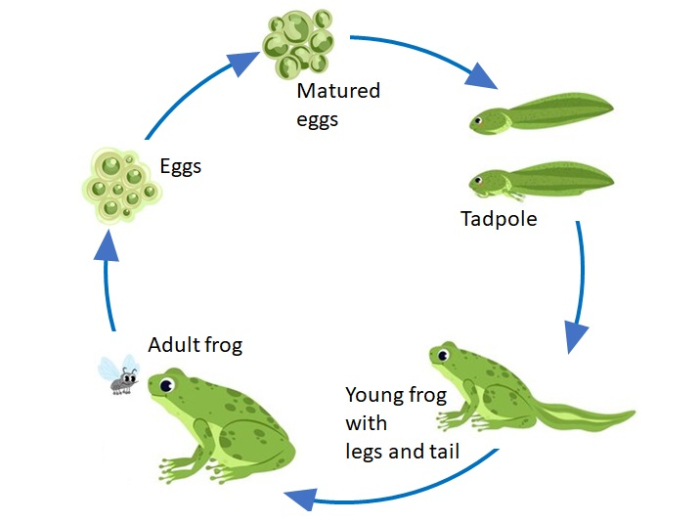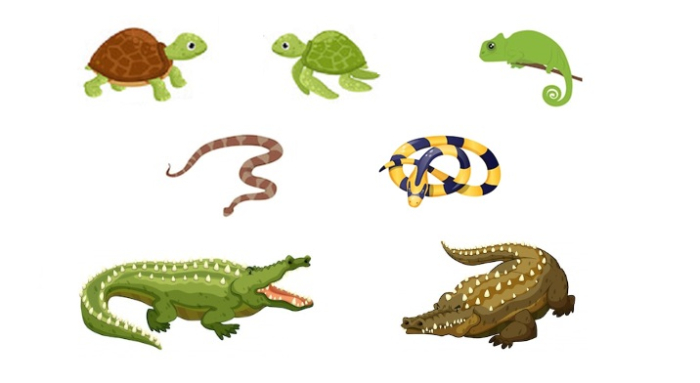
 Data Structure
Data Structure Networking
Networking RDBMS
RDBMS Operating System
Operating System Java
Java MS Excel
MS Excel iOS
iOS HTML
HTML CSS
CSS Android
Android Python
Python C Programming
C Programming C++
C++ C#
C# MongoDB
MongoDB MySQL
MySQL Javascript
Javascript PHP
PHP
- Selected Reading
- UPSC IAS Exams Notes
- Developer's Best Practices
- Questions and Answers
- Effective Resume Writing
- HR Interview Questions
- Computer Glossary
- Who is Who
Difference between Amphibians and Reptiles
Amphibians and Reptiles belong to the class Amphibia of kingdom Animalia. They both are vertebrates and cold-blooded. They are ectotherms, means they are responsible to control their body temperature by relying upon external environment. They have extraordinary eyesight which helps them to hunt their prey. There are around 7000 species Amphibians and 10,000 species of reptiles found all over the world. Amphibians and Reptiles both have been living on Earth since more than 300 million years.
Despite these similarities, they have some differences in their appearance and life forms. Go through this article to understand how exactly Amphibians differ from Reptiles.
What are Amphibians?
Amphibians are the group of animals who have a unique ability to thrive equally in water as well as on land. They are tetrapod animals with two different life stages in their single life. Most of the Amphibians are frogs and toads.
Types of Amphibians
There are three types of Amphibians ?
Anura ? Frogs and Toads
Apoda ? Caecilians, which live beside streams
Urodela ? Newts and Salamanders, which possess tails
Characteristics of Amphibians
There are some prominent characteristics of Amphibians as listed below ?
External Egg Fertilization ? Amphibians can fertilize their eggs after the eggs are released. They don't require mating to fertilize eggs. They release a clutch of covered with jelly-like cover and fertilize them after releasing.
Body ? Amphibians follow the development process of metamorphosis, in which they transform body abruptly from the start of the life up to being an adult. Amphibians start life as a larva. They develop a vertebral column and skeleton and end up as an adult having legs, lungs and a specific body shape.
Blood Type ? Amphibians are cold-blooded animals. Means they body temperature depends on their habitat.
Appetite ? They are carnivorous.
Presence of Lungs ? They possess primitive lungs.
Presence of Vertebral Column ? They have vertebral column.
Habitat ? They start their life in water. They grow up to live on land. They need moist environment to live on land.

How are Amphibians Useful to Mankind?
Amphibians can be useful to mankind in numerous ways as stated below ?
Human Aid ? Some Amphibians catch mosquitos which contribute to benefit human health. They are used in labs as live models for dissection.
Food Value ? Some Amphibians like frogs are taken as a delicacy in some food cultures of the world, particularly of South-East Asia.
Ecosystem Value ? Amphibians control the number of insects and pests which helps in farms and fields.
What are Reptiles?
Reptiles are vertebrates having scales, soft bony plates, or both on their body. Every species in this class has a common ancestor, the dinosaur. Examples of Reptiles include Alligators, Crocodiles, Lizards, Snakes, Tortoises, and Turtles.
Characteristics of Reptiles
Here are some prominent characteristics ?
Internal Egg Fertilization ? Reptiles must undergo copulation to be able to fertilize their eggs before the egg are released outside their body. The eggs of reptiles are enclosed in thin calcium shells. Some reptiles copulate to produce their young.
Body ? They have scaly or bony plates-like continuous cover on their epiderma. These thick scales help them to retain moisture in the body and protect them from predators.
Presence of Vertebral Column ? They have vertebral column.
Presence of Lungs ? They have lungs with more surface area, which makes them adapt the life on land.
Habitat ? Reptiles can live on variety of climates and territories such as wetland, seaside, and desert areas.

How are Reptiles Useful to Mankind?
Reptiles can be useful to mankind in numerous ways as stated below ?
Medicinal Value ? Some reptiles provide medicines on respiratory disorders. Antivenom drug used on snake sting is made from snake's venom itself.
Ecosystem Value ? Some reptiles control the number of insects and moles in farms and fields.
Commercial Value ? Crocodile skin is used for making leather goods.
Food Value ? Some reptiles are considered as a source of food in some countries.
Pets ? Some reptiles like Iguana and small species of tortoises and turtles are kept as pet.
Difference between Amphibians and Reptiles
Here are some prominent differences between Amphibians and Reptiles ?
| Key Factor | Amphibians | Reptiles |
|---|---|---|
| Skin | They have skin on their bodies. Their skin is capable of moving water into and out of their bodies. It is susceptible to climate changes. | Their skin has scales or bony plates on their bodies. |
| Respiration/Lungs | They have primitive lungs to be able to breath on land. They respirate with skin when they are in water. | They have more developed and efficient lungs than Amphibians' lungs. |
| Fertilization of Eggs | External, they do not need to mate to fertilize eggs in the body. | Internal or no fertilization. They need to mate for egg fertilization. Some reptiles can directly produce their young offspring. |
| Ectothermy | To regulate the body temperature Amphibians often undergo a period of Brumation (defined as the period of dormancy for coldblooded animals). Frogs dig burrows in cold/moist soil for brumation. | Reptiles regulate their body temperature during winter by basking in Sun to get the heat and by staying in water or moist areas to bring down the body heat. To dissipate the heat from body during hot days, reptiles often keep their jaws wide open and remain still. |
| Life Stages | They have two life stages after their eggs are hatched: one in water as a tadpole and another as an adult tetrapod Amphibian. Hence the young hatchling doesn't look like an adult Amphibian. | They have only one life stage after their eggs are hatched. The young hatchling looks like a small copy of an adult Reptile. |
| Food | They eat small invertebrates such as insects, snails, spiders, etc. | They are omnivorous. Some reptiles like Tortoise can take only plan food whereas Crocodiles and Lizards catch insects and other animals as their pray. |
| Ability to be Patronized | Amphibians are less likely option to be kept as pets. | Reptiles like tortoises and turtles are human-friendly and can be kept as pet. |
Conclusion
Amphibians and Reptiles are vital members of aquatic and terrestrial ecosystems. Both are part of the food chain as predators as well as prey. Both are cold-blooded, ectothermic, vertebrate animals. However, it is seen that they are also different in their body structure, habitat, life-stages, and brumation.

